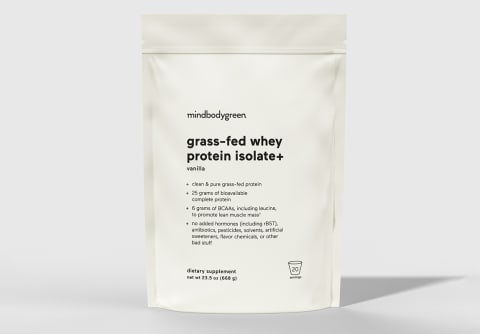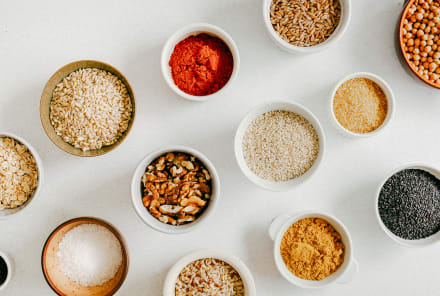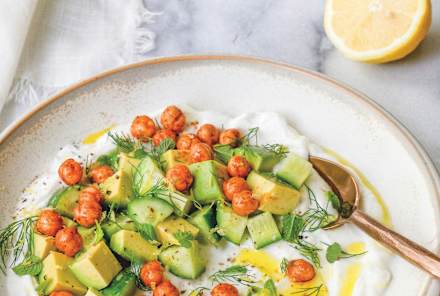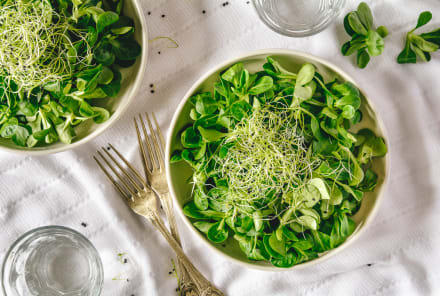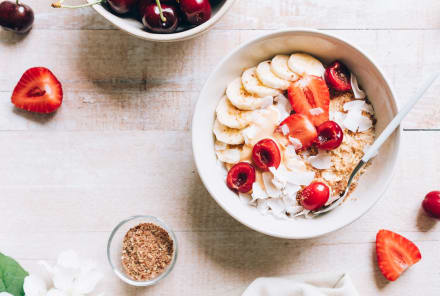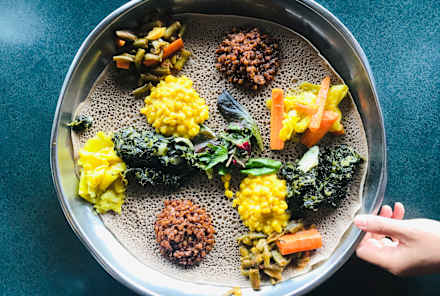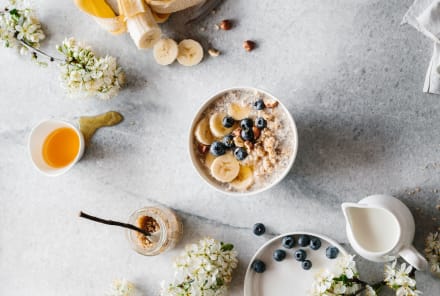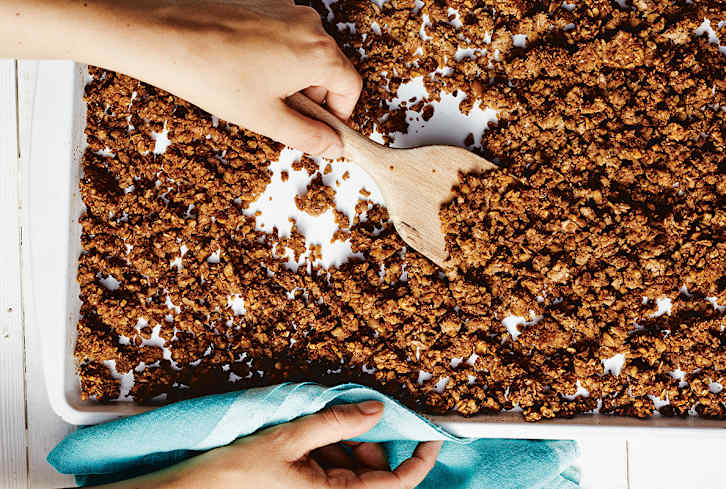Advertisement
16 Easy Ways To Eat More Protein + How Much You Need Daily

The topic of protein can be controversial, with clashing opinions regarding how much you need to eat and when.
We spoke with nutrition experts and protein scientists to figure out how much protein you need to eat, and help answer all your questions about how to get more of this macronutrient in your diet.
Why you need protein
Protein is well known for its role in rebuilding and repairing tissues broken down during exercise, like muscle tissue.
Protein isn’t just important for muscle, though. You need protein to survive and thrive. “Protein plays a role in building bones, muscles, cartilage, skin, and virtually every body part and tissue, "says registered dietitian nutritionist Alex Larson, MS, RDN. "It has a critical part in carrying oxygen in the blood, metabolic reactions, immune function, and brain function.”
While your body can store carbohydrates and fat, it doesn’t store protein the same way. Since your body is constantly breaking down and rebuilding new protein, you must eat adequate amounts to function well.
How much protein you need daily
So what is adequate when it comes to daily protein intake?
The recommended dietary allowance (RDA) for the average sedentary adult is a conservative 0.8 grams per kilogram of body weight per day (g/kg/d). That would look like 60 grams of protein for a person weighing 165 pounds (75 kilograms).
After consulting protein experts and digging into the research1, we believe that the RDA for protein is low and that most active people should aim to consume at least 100 grams of protein per day for optimal health.
The Journal of the International Society of Sports Nutrition (ISSN) takes that recommendation a step further and says active people looking to build or maintain muscle should eat 1.4 to 2.0 grams of protein per kilogram of body weight2. If you’re keeping score, that would be 105 to 150 grams of protein per day for a person weighing 165 pounds.
Resistance-trained individuals eating in a calorie deficit may need even higher protein intakes (2.3 to 3.1 g/kg/d) to minimize muscle loss during weight loss.
All that is to say, protein intake is individual and depends on several factors, including your age, weight, activity level, and goals. Your protein requirements will also change throughout your life. For example, women might need to adjust their protein intake during pregnancy and lactation to keep up with their body’s needs. People over 65 may also need to increase their protein intake since the body uses protein less efficiently as we age3.
So what happens if you don’t eat enough protein? Larson says you may experience symptoms like “a slow-healing injury, getting sick frequently, feeling more fatigued than normal, losing muscle mass, or seeing problems with your hair, nails, and skin.”
Summary
Protein quality
Not all protein is created equal—different sources are composed of different arrays of amino acids. Protein from animal sources contains all the essential amino acids that humans need to build and maintain muscle. Plant proteins often don't, and are therefore labeled "incomplete proteins."
One amino acid of particular importance is leucine, which plays a key role in stimulating muscle protein synthesis, says Stephan van Vliet, Ph.D., a scientist in the Center for Human Nutrition Studies at Utah State University who studies how food and physical activity impact human health.
When we consume adequate leucine, we stimulate the mTOR pathway4, which controls muscle protein synthesis (the creation of new muscle). Research shows that 2.5-3 grams of leucine are needed to stimulate muscle growth; this is known as the "leucine threshold."
It's much harder to reach this threshold with plant proteins than with animal proteins. To crunch the numbers, one 3.5-ounce serving of chicken breast contains5 2.3 grams of leucine. You would need to eat 5.3 ounces6 (about 2.5 servings) of lentils to reach this same threshold.
The same goes for protein powder supplements. "In whey protein, leucine is about 12%, so 23 grams of whey protein isolate will trigger [the 2.5 threshold], whereas in soy protein isolate, it's about 7.8%, so now you need 33 or 34 grams," leading amino acid requirements researcher Don Layman, Ph.D., previously told mindbodygreen.
Surveying shows that plant protein powders also tend to have a higher average heavy metal contamination than animal powders, so consuming them in large amounts comes with some risk.
Summary
Protein timing
Most people eat the bulk of their daily protein intake at dinner, which might not be a great strategy for building muscle7.
The latest research on protein timing suggests distributing protein in meals throughout the day to maximize muscle growth8.
And in general, Layman told mindbodygreen, "the first meal of the day after a nighttime fasting period is the most important for muscle protein synthesis (MPS)." MPS is a metabolic process9 that's important for building and maintaining muscle mass (so don't skip breakfast if you can help it).
While meeting your total daily protein intake is the first priority, eating a 0.25 to 0.40 g/kg dose10 of high-quality protein every three to four hours has been shown to improve body composition and performance in individuals who exercise.
Using our 165-pound person as an example, that would look like 19 to 30 grams of protein per meal.
In a review of the current literature, a dose of 0.40 to 0.55 g/kg protein per meal11 across a minimum of four meals was shown to maximize anabolism (essential for muscle growth). These numbers would help you hit a target of 1.6 to 2.2 g/kg total daily protein.
Summary
Protein-rich foods
Animal proteins:
Animal protein sources are considered "complete proteins" because they contain all the essential amino acids (including all-important leucine) in sufficient amounts.
This is a big plus, but one downside of animal protein is that it can be less sustainable than plant protein.
For example, for every kcal of protein that grain and bean proteins provide, they require two kcals of fossil fuel energy to produce, while beef requires 40 kcals of fossil fuel for every kcal of protein it provides. Producing one kilogram of animal protein also requires about 100 times more water12 than producing one kilogram of grain protein.
On the plus side, fossil fuel energy consumption can be reduced by about half13 if the animals are fed on high-quality pasture lands and raised regeneratively, instead of in factory farms. As a consumer, you can buy meat from small local farms or use sustainable meat subscription boxes to reduce your environmental impact.
A few top animal-based sources of protein are:
- Chicken (skinless)14: 56 grams/ one piece (6 oz)
- Turkey (roasted)15: 23.5 grams/ 3 oz
- Lamb (ground, raw)16: 22.9 grams/ 4 oz
- Pork (ground, raw)17: 19.1 grams/ 4 oz
- Salmon18: 16.9 grams/ 3 oz
- Tuna19: 19.8 grams/ 3 oz
- Shrimp20: 20.4 grams/ 3 oz
- Egg (large):21 6 grams/ egg
- Whole milk greek yogurt22: 9 grams/ 100g
- Whey protein powder: ~25 grams/ serving
If you want to get more protein without consuming more fat, you can choose lean proteins like skinless chicken breast.
Plant proteins:
Though plant-based proteins are considered incomplete proteins because they don’t provide a sufficient amount of all the essential amino acids, “They provide fiber and phytochemical antioxidants that benefit the health of our gut as well as our body’s ability to protect cells from outside stressors, thereby reducing the risk of chronic disease,” says performance dietitian and consultant, Kelly Jones MS, RD, CSSD.
A few top plant-based sources of protein are:
- Tempeh23: 20.3 grams/ 100 grams
- Lentils6: 24.6 grams/ 100 grams
- Black beans24: 21.6 grams/ 100 grams
- Almonds25: 21.2 grams/ 100 grams
- Edamame26: 11.9 grams/ 100 grams
- Kidney beans27: 25.9 grams/ 100 grams
- Firm tofu28: 12.4 grams/ 100 grams
- Chickpeas (canned, drained)29: 7.05 grams/ 100 grams
- Spirulina30: 12 grams/ 3 tablespoons
What about protein powders?
While taking a food-first approach is always wise, protein powder supplements offer a quick and convenient way to fill protein gaps in your diet.
Many protein powder options are available, from milk-based (whey) to plant-based, and even cricket, egg, or beef-derived protein supplements.
As we mentioned before, not all protein powders are created equal. It's best to choose a protein supplement that contains 25 to 30 grams of protein and minimal sugars or additives, plus 2.5 grams of leucine. A high-quality whey protein powder will fit the bill.
How to eat more protein
As a nutritionist who works with athletes and active people, I believe it’s easier than you think to eat 100 grams of protein per day. Here are some of my top tips and swaps for working more protein into your diet:
- Eat every three to four hours and include a protein-rich food with each meal and snack.
- Start your day with a hit of protein by stirring unflavored collagen into coffee, oatmeal, or a smoothie.
- Consider cooking protein in bulk to have it readily available throughout the week.
- For quick meals or snacks, stock up on pre-prepped or pre-cooked protein (canned tuna, Greek yogurt, rotisserie chicken, protein powder, etc.).
- Swap traditional pasta for a bean or lentil-based alternative such as chickpea pasta to get an extra protein boost.
- Swap white rice for quinoa to get almost double the protein.
- Use Greek yogurt instead of traditional yogurt to get twice the protein.
- Stock up on carbs that double as good protein sources (beans, lentils, chickpeas, etc.).
- Add hemp seeds or chia seeds to oatmeal or yogurt. Three tablespoons of hemp seeds provide nearly 10 grams of protein.
- Use bone broth as a base for soups or to cook rice.
- Use plain Greek yogurt instead of sour cream in recipes.
- Sprinkle raw nuts and seeds on other foods or eat a handful as a snack.
- Add beans or lentils to soups or pasta dishes. (Swap half the meat for lentils to make a hearty bolognese sauce!)
- Experiment with ancient grains like teff, spelt, and amaranth.
- Add peas to meals. One cup provides eight grams of protein.
- Add protein powder to pancakes or baked goods.
- Use nutritional yeast for a plant-based cheesy flavor. Two tablespoons provide five grams of protein.
Sample protein-packed meal plan:
Here is three days’ worth of nutritious, protein-rich meals for inspiration, including an entirely plant-based day (day 3) to accommodate different preferences:
Day 1:
- Breakfast: Scrambled eggs (with diced tomato, onion, and peppers), sprouted grain toast, and orange slices
- Lunch: Tuna salad wrap with raw veggies and hummus
- Dinner: Chickpea pasta with a ground chicken meat sauce and Greek salad
- Snack 1: Greek yogurt with berries, pumpkin seeds, hemp seeds, and a drizzle of pure maple syrup or honey
- Snack 2: Oatmeal chocolate chip cookie and glass of milk
Day 2:
- Breakfast: Turkey breakfast sausages, avocado toast, and apple with cinnamon
- Lunch: Chicken salad wrap with raw veggies and hummus
- Dinner: Salmon, roasted sweet potatoes, and green beans
- Snack 1: Nut butter and whole grain crackers
- Snack 2: Chia pudding and berries with a square of dark chocolate
Day 3 (plant-based):
- Breakfast: A protein shake with whey protein
- Lunch: Lentil soup and a garden salad
- Dinner: Buddha bowl (quinoa, chickpeas, sweet potato, and broccoli with a tahini dressing)
- Snack 1: Pita bread and hummus
- Snack 2:Trail mix with nuts, seeds, dried fruit, and dark chocolate chips
Find more high-protein meal ideas here:
Side effects
Healthy people without pre-existing kidney or liver damage or dysfunction don’t need to worry too much about overeating protein.
What you need to watch for is an excessive intake of protein primarily from animal products. “High protein foods may be higher in total fat and saturated fat, which can lead to high blood cholesterol lipids and heart disease,” advises Larson.
A high-protein diet can also crowd out essential nutrients from carbohydrates and fats, like vitamins, minerals, fiber, and antioxidants.
Consult with your physician or a registered dietitian if you have any questions about your personal protein needs.
Frequently Asked Questions
How do you eat more protein as a vegetarian?
Add a variety of plant-based protein sources to your plate to create a balanced amino acid profile. Sprinkle nuts, seeds, or nutritional yeast onto meals for an extra protein boost, and load up on high-protein vegetables.
What foods are highest in protein?
Chicken, steak, turkey, lamb, pork, and salmon are at the top of the protein foods list. Plant-based foods like tempeh, lentils, black beans, and edamame are also good sources of protein.
How do I eat 100 grams of protein a day?
Eat every three to four hours and include a protein-rich food with every meal and snack. Aim for 20 to 40 grams of protein per meal. Use our strategies above to get more protein into your diet.
The takeaway
The RDA for protein is just the bare minimum you need to eat to avoid protein deficiency. Many studies have shown that even sedentary people would benefit from eating more protein daily—and it's not all that hard to do. By making a few simple swaps, you can incorporate more protein-rich ingredients into your diet to maximize your muscle strength, athletic performance, and overall health.
30 Sources
- https://www.ncbi.nlm.nih.gov/pmc/articles/PMC5872778/
- https://pubmed.ncbi.nlm.nih.gov/28642676/
- https://www.ncbi.nlm.nih.gov/pmc/articles/PMC3060646/
- https://www.frontiersin.org/articles/10.3389/fphys.2017.00788/full
- https://fdc.nal.usda.gov/fdc-app.html#/food-details/171477/nutrients
- https://fdc.nal.usda.gov/fdc-app.html#/food-details/172420/nutrients
- https://pubmed.ncbi.nlm.nih.gov/34233179/
- https://pubmed.ncbi.nlm.nih.gov/32321161/
- https://pubmed.ncbi.nlm.nih.gov/34697259/
- https://pubmed.ncbi.nlm.nih.gov/28919842/
- https://pubmed.ncbi.nlm.nih.gov/29497353/
- https://www.ncbi.nlm.nih.gov/pmc/articles/PMC7760812/
- https://www.ncbi.nlm.nih.gov/pmc/articles/PMC7435039/
- https://fdc.nal.usda.gov/fdc-app.html#/food-details/331960/nutrients
- https://fdc.nal.usda.gov/fdc-app.html#/food-details/171091/nutrients
- https://fdc.nal.usda.gov/fdc-app.html#/food-details/172617/nutrients
- https://fdc.nal.usda.gov/fdc-app.html#/food-details/167902/nutrients
- https://fdc.nal.usda.gov/fdc-app.html#/food-details/173688/nutrients
- https://fdc.nal.usda.gov/fdc-app.html#/food-details/173706/nutrients
- https://fdc.nal.usda.gov/fdc-app.html#/food-details/175180/nutrients
- https://fdc.nal.usda.gov/fdc-app.html#/food-details/748967/nutrients
- https://fdc.nal.usda.gov/fdc-app.html#/food-details/171304/nutrients
- https://fdc.nal.usda.gov/fdc-app.html#/food-details/174272/nutrients
- https://fdc.nal.usda.gov/fdc-app.html#/food-details/173734/nutrients
- https://fdc.nal.usda.gov/fdc-app.html#/food-details/170567/nutrients
- https://fdc.nal.usda.gov/fdc-app.html#/food-details/168411/nutrients
- https://fdc.nal.usda.gov/fdc-app.html#/food-details/747440/nutrients
- https://fdc.nal.usda.gov/fdc-app.html#/food-details/174297/nutrients
- https://fdc.nal.usda.gov/fdc-app.html#/food-details/173800/nutrients
- https://fdc.nal.usda.gov/fdc-app.html#/food-details/170495/nutrients

Why Nutrition Is Key To Changing Your Relationship With Alcohol
Brooke Scheller, DCN, CNS

Why Alcohol Sabotages Your Gut Health & How To Get Back On Track
Brooke Scheller, DCN, CNS

Why Nutrition Is Key To Changing Your Relationship With Alcohol
Brooke Scheller, DCN, CNS

Why Alcohol Sabotages Your Gut Health & How To Get Back On Track
Brooke Scheller, DCN, CNS

Why Nutrition Is Key To Changing Your Relationship With Alcohol
Brooke Scheller, DCN, CNS

Why Alcohol Sabotages Your Gut Health & How To Get Back On Track
Brooke Scheller, DCN, CNS

Why Nutrition Is Key To Changing Your Relationship With Alcohol
Brooke Scheller, DCN, CNS

Why Alcohol Sabotages Your Gut Health & How To Get Back On Track
Brooke Scheller, DCN, CNS
